Related Research Articles

After registering steady increases during the Soviet period, the population of Armenia declined from its peak value of 3.633 million in 1992 to 2.986 million in 2017.

The beagle is a breed of small scent hound, similar in appearance to the much larger foxhound. The beagle was developed primarily for hunting hare, known as beagling. Possessing a great sense of smell and superior tracking instincts, the beagle is the primary breed used as a detection dog for prohibited agricultural imports and foodstuffs in quarantine around the world. The beagle is a popular pet due to its size, good temper, and a lack of inherited health problems.

Rabbits, also known as bunnies or bunny rabbits, are small mammals in the family Leporidae, which is in the order Lagomorpha. Oryctolagus cuniculus is the European rabbit, including its descendants, the world's 305 breeds of domestic rabbit. Sylvilagus includes 13 wild rabbit species, among them the seven types of cottontail. The European rabbit, which has been introduced on every continent except Antarctica, is familiar throughout the world as a wild prey animal, a domesticated form of livestock and a pet. With its widespread effect on ecologies and cultures, in many areas of the world, the rabbit is a part of daily life – as food, clothing, a companion, and a source of artistic inspiration.

The Shiba Inu is a breed of hunting dog from Japan. A small-to-medium breed, it is the smallest of the six original breed of dogs native to Japan. Its name literally translates to "brushwood dog", as it is used to flush game.
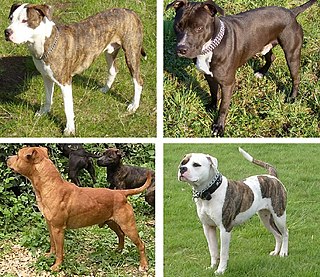
Pit bull is a term used in the United States for a type of dog believed to have descended from bull and terriers, while in other countries such as the United Kingdom the term is used as an abbreviation of the American Pit Bull Terrier breed. Within the United States the pit bull is usually considered a diverse grouping that includes the breeds American Pit Bull Terrier, American Staffordshire Terrier, American Bully, Staffordshire Bull Terrier and occasionally the American Bulldog, along with any crossbred dog that shares certain physical characteristics with these breeds. In other countries including Britain, the Staffordshire Bull Terrier is not considered a pit bull. Most pit bull-type dogs descend from the British Bull and terrier, a 19th-century dog-fighting type developed from crosses between the Old English Bulldog and the Old English Terrier.
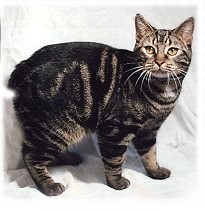
The Manx cat is a breed of domestic cat originating on the Isle of Man, with a mutation that shortens the tail. Many Manx have a small stub of a tail, but Manx cats are best known as being entirely tailless; this is the most distinguishing characteristic of the breed, along with elongated hind legs and a rounded head. Manx cats come in all coat colours and patterns, though all-white specimens are rare, and the coat range of the original stock was more limited. Long-haired variants are sometimes considered a separate breed, the Cymric.

The Angora rabbit, which is one of the oldest types of domestic rabbit, is bred for the long fibers of its coat, known as Angora wool, which are gathered by shearing, combing or plucking. Because rabbits do not possess the same allergy-causing qualities as many other animals, their wool is an important alternative. There are at least 11 distinct breeds of Angora rabbit, four of which are currently recognized by the American Rabbit Breeders Association (ARBA): English Angora, French Angora, Giant Angora and Satin Angora. Others include German Angora, Chinese Angora, Finnish Angora, Japanese Angora, Korean Angora, Russian Angora, St Lucian Angora and Swiss Angora.
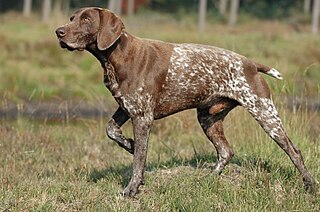
The German Shorthaired Pointer is a breed of medium-sized pointing dog developed in nineteenth century Germany. It is energetic and powerful, with strong legs and great endurance. It is a versatile all-purpose gun dog suitable for hunting and retrieving on both land and water, with a strong drive to find and chase game. It may also be kept as a companion dog, though as a high-energy sporting dog, it requires significant amounts of exercise.

The Sealyham Terrier is a rare Welsh breed of small to medium-sized terrier that originated in Wales as a working dog. It is principally a white-bodied, rough-coated breed, developed in the mid-to-late-19th century by Captain John Edwardes at Sealyham House, Pembrokeshire.

The domestic or domesticatedrabbit—more commonly known as a pet rabbit, bunny, bun, or bunny rabbit—is the domesticated form of the European rabbit, a member of the lagomorph order. A male rabbit is known as a buck, a female is a doe, and a young rabbit is a kit, or kitten.

Dwarf rabbit refers either (formally) to a rabbit with the dwarfing gene, or (informally) to any small breed of domestic rabbit or specimen thereof, or (colloquially) to any small rabbit. Dwarfism is a genetic condition that may occur in humans and in many animals, including rabbits. True dwarfism is often associated with a cluster of physical abnormalities, including pituitary dwarfism. The process of dwarfing is used to selectively breed for smaller stature with each generation. Small stature is a characteristic of neoteny, which may account for the attraction of dwarf animals.

Rabbit show jumping, also known as rabbit agility or rabbit hopping, is an animal sport where the animals are led through a course by their owners, modelled after horse show jumping. It is typically conducted in a closed, indoor arena, with obstacles scaled to suit the rabbits. Competitions have been held in the United States and several European countries. As rabbits are common domestic pets, some owners train their pet rabbits for this sport.

Holland Lop is a breed of lop-eared rabbit that was recognized by the American Rabbit Breeders Association (ARBA) in 1979. The Holland Lop, with a maximum weight of 1.8 kg (4 lb), is one of the smallest lop-eared breeds.
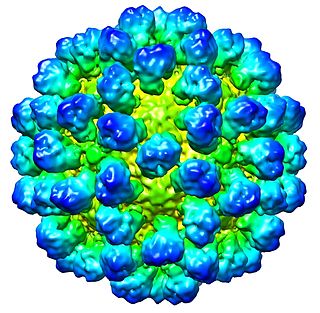
Rabbit hemorrhagic disease (RHD), also known as viral hemorrhagic disease (VHD), is a highly infectious and lethal form of viral hepatitis that affects European rabbits. Some viral strains also affect hares and cottontail rabbits. Mortality rates generally range from 70 to 100 percent. The disease is caused by strains of rabbit hemorrhagic disease virus (RHDV), a lagovirus in the family Caliciviridae.
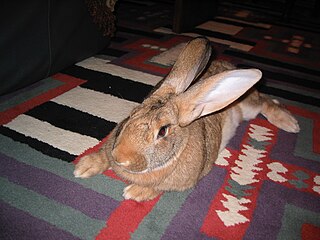
The Flemish Giant rabbit is the largest breed of domestic rabbit. Flemish Giants are historically a utility breed used for their fur and meat. They are often kept as pets as they are known for being docile and patient when being handled.
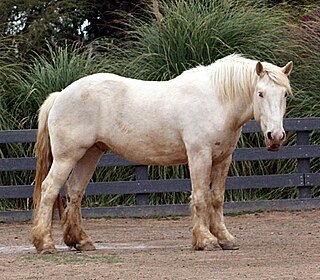
In modern agriculture, a rare breed is a breed of poultry or livestock that has a very small breeding population, usually from a few hundred to a few thousand. Because of their small numbers, rare breeds may have a threatened conservation status, and they may be protected under regional laws. Many countries have organizations devoted to the protection and promotion of rare breeds, for which they each have their own definition. In botany and horticulture, the parallel to rare animal breeds are heirloom plants, which are rare cultivars.

The European rabbit, or coney, is a species of rabbit native to the Iberian Peninsula, western France, and the northern Atlas Mountains in northwest Africa. It has been widely introduced elsewhere, often with devastating effects on local biodiversity. Its decline in its native range due to myxomatosis, rabbit hemorrhagic disease, overhunting and habitat loss has caused the decline of the Iberian lynx and Spanish imperial eagle. It is known as an invasive species because it has been introduced to countries on all continents with the exception of Antarctica, and has caused many problems within the environment and ecosystems; in particular, European rabbits in Australia have had a devastating impact, due in part to the lack of natural predators there.

The Blanc de Hotot is a medium-sized rabbit breed originally developed in France. It is a compact, thickset white rabbit with spectacle-like black rings around each dark eye. First bred in Hotot-en-Auge, Normandy, France in the early 1900s, the breed spread throughout Europe and into North America by the 1920s. Initially unpopular in the United States, it died out there, and suffered population decline in World War II-era Europe. It began to spread again in the 1960s and 1970s, and was re-imported to the US in 1978. Today it is recognized by the British Rabbit Council and the American Rabbit Breeders Association, but is considered globally endangered, with a listing of "threatened" status by the American Livestock Breeds Conservancy.
References
- 1 2 3 "Country Report On the State of the Armenian Animal Genetic Resources" (PDF). Food and Agriculture Organization of the United Nations. Archived from the original (PDF) on 25 August 2019. Retrieved 26 August 2019.
- ↑ "Republic of Armenia First National Report" (PDF). Convention on Biological Diversity. Retrieved 26 August 2019.
- ↑ "Armenian Marder/Rabbit/Armenia". EFABIS. Retrieved 26 August 2019.